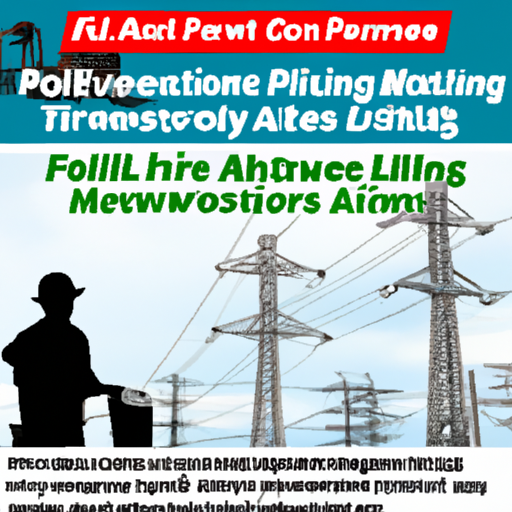So you’re curious about how to repair powerlines as a lineman? Well, you’ve come to the right place! In this article, we’re going to guide you through the step-by-step process of how to repair powerlines, helping you gain a deeper understanding of the work and skills required in this line of work.
In this comprehensive guide, we will cover everything from the necessary equipment you’ll need to have, safety precautions to take, and the actual step-by-step process of repairing powerlines. Whether you’re interested in pursuing a career as a lineman or simply want to learn more about this essential job, this article will provide you with all the information you need. So, let’s dive in and explore the world of powerline repair together!

A Step-by-Step Guide on How to Repair Powerlines as a Lineman
Powerlines are crucial in delivering electricity to homes, businesses, and communities. However, these powerlines are not immune to damages caused by weather, accidents, or other unforeseen circumstances. As a lineman, it is your responsibility to ensure the safety and reliability of powerlines by performing diligent repairs when necessary. In this step-by-step guide, we will walk you through the process of powerline repair, from understanding the components to testing and inspecting repairs.
Ensuring Safety and Reliability
The importance of powerline repair cannot be overstated when it comes to ensuring the safety and reliability of the electrical supply. Damaged or faulty powerlines can pose serious risks, including electrical shocks, fires, and power outages. By promptly and effectively repairing powerlines, you play a vital role in maintaining a safe and reliable electrical infrastructure.
Preventing Power Outages
Power outages can have a significant impact on individuals and communities. They can disrupt daily activities, halt businesses, and compromise safety and security. As a lineman, your primary goal is to minimize power outages and restore electricity as quickly as possible. By promptly repairing powerlines, you ensure uninterrupted power supply to households, essential services, and critical infrastructure.
Understanding Powerline Components
Before delving into the repair process, it’s crucial to understand the key components of a powerline. Powerlines consist of transmission lines, distribution lines, and transformers. Each component serves a specific purpose and requires different repair techniques.
Transmission Lines
Transmission lines are responsible for carrying high voltage electricity over long distances. These lines are typically supported by towers or poles and are made of conductors, insulators, and other supporting hardware. Repairing transmission lines often involves replacing damaged conductors, inspecting and repairing insulators, and installing spacer dampers.
Distribution Lines
Distribution lines, on the other hand, deliver electricity from transmission lines to individual homes and businesses. These lines are located closer to the ground and generally carry lower voltages. Repairing distribution lines often involves fixing broken insulation, replacing faulty connectors, and installing new pole hardware.
Transformers
Transformers play a crucial role in regulating the voltage of the electricity being delivered. They are responsible for stepping-down the high voltage of transmission lines to a lower voltage suitable for distribution. Repairing transformers may involve testing and troubleshooting issues, replacing faulty components, and reinsulating and sealing.
Safety Precautions and Equipment
Safety should always be a top priority when working on powerlines. As a lineman, you are exposed to various hazards, including electrical shocks, falls, and hazardous materials. Therefore, it is essential to follow proper safety protocols and use the appropriate safety equipment.
Proper Safety Gear
Wearing the right safety gear can significantly reduce the risk of injuries. This gear may include personal protective equipment (PPE) such as hard hats, safety glasses, gloves, and flame-resistant clothing. It is crucial to ensure that your safety gear is in good condition and meets the required industry standards.
Lockout-Tagout Procedures
Before beginning any repair work, it is essential to implement lockout-tagout procedures. These procedures involve disconnecting the power source and locking and tagging the switch or breaker to prevent accidental power restoration. Lockout-tagout procedures provide an additional layer of safety by ensuring that powerlines remain de-energized during the repair process.
Using Insulated Tools
When working on powerlines, it is crucial to use insulated tools to avoid electrical shocks. Insulated tools have non-conductive handles that provide protection against accidental contact with live electrical components. Adding this extra layer of protection can significantly reduce the risk of electrocution and enhance the safety of the repair process.
Powerline Repair Process
The powerline repair process can be divided into several key steps, including assessment and planning, isolation of the line, and removing faulty components. Let’s delve into each of these steps in detail.
Assessment and Planning
Before repairing a powerline, it is necessary to assess the extent of the damage and develop a repair plan. This involves inspecting the powerline, identifying the faulty components, and determining the best course of action. Careful planning ensures that the repair process is efficient and minimizes any further disruptions to the electrical supply.
Isolation of the Line
Once the assessment and planning stage is complete, the next step is to isolate the affected section of the powerline. This involves disconnecting the power source and implementing lockout-tagout procedures to ensure the safety of the lineman and prevent accidental power restoration. Isolating the line creates a secure work environment for the repair process to proceed.
Removing Faulty Components
After the line is isolated, the lineman must remove the faulty components that are causing the powerline issues. This may involve detaching damaged conductors, insulators, connectors, or other components that are no longer functioning correctly. Care should be taken to handle and dispose of these components safely, adhering to industry regulations and environmental guidelines.
Repairing Transmission Lines
Repairing transmission lines requires specialized skills and equipment due to the higher voltage levels involved. Let’s explore the key steps involved in repairing transmission lines.
Replacing Damaged Conductors
Damaged or broken conductors can compromise the integrity of the powerline and hinder the proper transmission of electricity. Repairing transmission lines often involves replacing these damaged conductors. The process may vary depending on the type of conductor and the severity of the damage. Proper installation techniques and safety precautions should be followed to ensure a secure and efficient repair.
Inspecting and Repairing Insulators
Insulators play a critical role in maintaining proper electrical insulation and preventing electrical leakage. During the repair process, it is essential to inspect the insulators thoroughly and identify any signs of damage or wear. Damaged insulators should be repaired or replaced to ensure the powerline’s optimal performance and safety.
Installing Spacer Dampers
Spacer dampers help maintain the proper spacing between conductors on transmission lines. They reduce the risk of high winds or other external factors causing the conductors to touch, which can lead to power outages or even electrical faults. Installing spacer dampers during the repair process helps ensure the longevity and reliability of the powerline.
Repairing Distribution Lines
Repairing distribution lines involves addressing issues closer to the ground and delivering electricity to homes and businesses. Let’s explore the key steps involved in repairing distribution lines.
Fixing Broken Insulation
Distribution lines often have insulated wires that protect against electrical leakage and shocks. During the repair process, it is crucial to identify and fix any broken or damaged insulation to ensure the safe delivery of electricity. Damaged insulation should be carefully repaired or replaced to maintain the integrity of the distribution line.
Replacing Faulty Connectors
Faulty connectors can cause electricity leakage, inadequate power delivery, or even power outages. It is essential to inspect the connectors thoroughly and replace any faulty or corroded connectors found during the repair process. Proper installation techniques and using the right connectors are vital to ensure a secure and reliable electrical connection.
Installing New Pole Hardware
Pole hardware plays a crucial role in securing distribution lines and supporting the weight of the wires. During the repair process, it is necessary to inspect the pole hardware and replace any damaged or deteriorated components. Installing new pole hardware helps ensure the stability and longevity of the distribution line.
Repairing Transformers
Transformers are vital components in the power distribution process, stepping down high voltage electricity to a lower, safer voltage. Repairing transformers requires careful troubleshooting and adherence to safety protocols. Let’s explore the key steps involved in repairing transformers.
Testing and Troubleshooting Issues
Before repairing a transformer, it is crucial to identify and troubleshoot any issues it may have. This may involve conducting electrical tests to determine the extent of the problem and the specific components that need repair or replacement. Thorough testing ensures an accurate diagnosis and allows for an effective repair plan.
Replacing Faulty Components
Once the problematic components of a transformer are identified, it is necessary to replace them to restore its proper functioning. This may involve replacing faulty capacitors, coils, or other internal components that are affecting the transformer’s performance. Following proper installation techniques and safety precautions is essential during the replacement process.
Reinsulating and Sealing
After the faulty components are replaced, it is crucial to reinsulate and seal the transformer to protect it from moisture, dust, or other environmental factors. Reinsulating and sealing ensure the longevity and reliability of the transformer, preventing further damage or performance issues.
Testing and Inspecting Repairs
Once the repair process is complete, it is essential to conduct thorough testing and inspection to ensure the efficacy and safety of the repairs. Electrical tests should be performed to verify proper functionality, including voltage regulation, insulation resistance, and phase balance. Additionally, a visual inspection of the repaired components should be carried out to identify any potential issues or defects.
Restoring Power and Final Checks
After testing and inspecting the repairs, the final steps involve restoring power, verifying power restoration, and documenting and reporting the completed repairs.
Reconnecting the Powerline
Once the repairs are deemed successful and safe, the lineman can proceed to reconnect the powerline. Following proper procedures, such as implementing lockout-tagout procedures, ensures proper and safe power restoration.
Verifying Power Restoration
After the powerline is reconnected, it is crucial to verify that power has been successfully restored to the affected areas. Thorough checks and tests should be carried out to ensure that there are no further issues or disruptions in the electrical supply.
Documentation and Reporting
Finally, it is essential to document and report the completed repairs. This includes detailing the repairs performed, any components that were replaced, and any follow-up recommendations for future maintenance or upgrades. Accurate documentation and reporting help maintain a comprehensive repair history and promote continuous improvement in powerline maintenance and repair processes.
Conclusion
As a lineman, your role in powerline repair is of utmost importance. By diligently following the step-by-step guide outlined in this article, you contribute to the safety and reliability of the electrical supply. Continuous training and adaptability are crucial to staying ahead of evolving technologies and best practices in powerline repair. Remember, your work as a lineman plays a significant part in keeping communities powered and connected.




